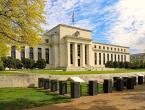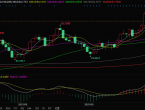On Friday (October 15), the US dollar index rose in response to the announcement of retail data, but then fell, falling 0.04% in late trading to 93.94; the 10-year US Treasury yield rose 6 basis points to 1.57%, stopping for three days Streak. As U.S. corporate profits exceeded expectations and concerns about economic stagflation have eased, global stock markets rebounded this week.
The unexpectedly strong September retail sales data in the US also boosted market sentiment. Retail sales last month increased by 0.7% compared with the previous month, which was partly due to rising prices, which are expected to fall by 0.2%. Boris Schlossberg, managing director of the foreign exchange strategy department of BK Asset Management, said that the current risk appetite is still very, very strong. This has helped riskier currencies such as the pound, euro and Australian dollar simply because the market feels more optimistic.
Marc Chandler of Bannockburn said in a report that although the overall sentiment is bullish, "my opinion is that the market has digested a lot of the dollar's positives and is a bit too much in anticipating the Fed's enthusiasm for tightening policy."
Since the beginning of September, the U.S. dollar has risen against major currencies. The market expects that facing economic improvement and soaring energy prices, the Fed will tighten monetary policy faster than previously expected.
The minutes of the Fed’s September meeting released this week confirmed that it is almost certain that the stimulus plan will begin to be scaled down this year, despite the serious disagreement among policymakers on inflation and how to deal with it.
The currency market currently predicts that the probability of the Fed raising interest rates by 25 basis points by July next year is about 50%.
Marc Chandler, chief market strategist at Bannockburn Global Forex, said that the U.S. dollar has strengthened sharply because of the expectation that the Fed may start raising interest rates earlier than expected, but this expectation may be excessive and the U.S. dollar is currently consolidating. Next week will help clarify whether the dollar is consolidating and whether this round of consolidation is just a respite or a prelude to a correction.
The euro rose 0.03% to 1.1601 against the dollar; the dollar rose to a three-year high against the yen, but reduced some of the earlier gains. The dollar rose 0.48% to 114.22 against the yen in late trading. The yen is a safe-haven currency. It was hit by a rebound in risk sentiment, including Asian markets. The euro rose against the yen for the seventh consecutive day, the longest consecutive rise since June 2020.
The pound rose 0.56% to 1.3750 against the dollar, hitting the highest level of 1.3773 since September 17 during the session; Adam Cole of the Royal Bank of Canada wrote that the decoupling of the pound movement from the interest rate cycle indicates that it is either a short-term cyclical pressure or a market attempt. Tell us about the UK’s long-term inflation outlook or its access to international capital. Regardless, we think there is room for a medium-term downside for the pound.
The U.S. dollar fell 0.02% to 1.2368 against the Canadian dollar. The Canadian dollar reduced its earlier gains due to profit-taking. The U.S. dollar rose 0.2% to the Canadian dollar to 1.2397; however, as the WTI oil price remained above $80 per barrel, the The currency pair has fallen for the fourth consecutive week.
The risk-sensitive currency, the Australian dollar rose 0.08% to 0.7422, and climbed to 0.7439 earlier in the session; the New Zealand dollar rose 0.43% to 0.7066 against the US dollar, marking the third consecutive day of gains; BDSwiss' Marshall Gittler wrote that although the market has been Raise expectations for the rate of normalization of the New Zealand Fed’s policy, but "further inflation may further push up these expectations", which may boost the New Zealand dollar.
Monday preview
| time | area | index | The former value | Predictive value |
| 05:45 | new Zealand | CPI annual rate in the third quarter (%) | 3.3 | 4.2 |
| 10:00 | China | Third quarter GDP annual rate-single quarter (%) | 7.9 | 5 |
| 10:00 | China | GDP quarterly rate in the third quarter (%) | 1.3 | 0.4 |
| 10:00 | China | Total GDP in the third quarter (100 million yuan) | 282857 | |
| 10:00 | China | Annual rate of added value of industrial enterprises above designated size in September-YTD (%) | 13.1 | 12.2 |
| 10:00 | China | Annual rate of added value of industrial enterprises above designated size in September (%) | 5.3 | 3.8 |
| 10:00 | China | Annual rate of total retail sales of consumer goods in September (%) | 2.5 | 3.5 |
| 10:00 | China | Monthly rate of total retail sales of consumer goods in September (%) | 0.17 | |
| 10:00 | China | Annual rate of total retail sales of consumer goods in September-YTD (%) | 18.1 | 16.3 |
| 10:00 | China | Annual rate of urban fixed asset investment in September-YTD (%) | 8.9 | 7.8 |
| 21:15 | America | Monthly rate of industrial output in September (%) | 0.4 | 0.2 |
10:00 The State Council Information Office held a press conference. Fu Linghui, spokesperson of the National Bureau of Statistics and Director of the General Statistics Department of the National Economy, introduced the operation of the national economy in the first three quarters of 2021, and answered reporters’ questions at 02:15 in the morning, Minneapolis Liss Fed President Kashkari delivered a speech
Summary of Institutional Views
Mitsubishi Tokyo UFJ: The fall of the dollar seems to be a short-lived
Mitsubishi Tokyo UFJ Financial Group believes that there are enough reasons to believe that the dollar's weakness is more like a position squeeze rather than any significant change in the global macro background. The 2-year z-score indicator shows that the overall dollar position is at the highest level since 2015. The extreme state indicates that the decline in the US dollar is related to the excessive increase in long positions. These long positions are currently being liquidated. The US dollar will still be well supported throughout the fourth quarter. It is also based on the fact that the uncertainty of global growth still exists, and the CRB index has risen again. , But suspect that this is a sign of increased growth optimism, so this correlation with a weaker U.S. dollar is unlikely to continue
Scotiabank: The euro against the US dollar may fall sharply to 1.11, and the US dollar against the Canadian dollar will slightly fall to the 1.22 area
Scotiabank believes that the euro against the US dollar EUR/USD may fall to the 1.11 level. As the Eurozone economic data showed weakness in the industrial sector and the continued energy crisis, the main European Central Bank policymakers said that easing policies will continue to exist for a period of time. It is recommended to short the euro against the US dollar on rallies. The short-term target is the 1.14 area, and it is expected to further drop to the 1.11 level in the next few months.
The overall rise of the US dollar has been suspended, paving the way for the Canadian dollar to take full advantage of high crude oil prices and widening short-term spreads. Taking into account the overall performance of the U.S. dollar, it is estimated that the fair value of the spot Canadian dollar is currently closer to 1.2344, and the bank still believes that the window for the Canadian dollar in the next few weeks has been further opened, advancing to the 1.22 to 1.23 area. If the US dollar/Canadian dollar USD/CAD falls below the 1.2367 support level, it will open up the downside and further fall back to 1.22.
Mizuho: The Bank of England's interest rate hike in 2021 should be a policy error, and it is expected to start raising interest rates to 1.5% in February next year
Bank of England commissioner Tenreiro warned on Thursday that raising interest rates in response to temporary increases in inflation would be "self-defeating." Mizuho said that most members of the Monetary Policy Committee may agree with this view and said that raising interest rates this year would be a policy error. Panic rate hikes will be counterproductive, and the Bank of England Monetary Policy Committee may eventually provide a slow but strong path for rate hikes between February 2022 and 2025. Within this time frame, the Bank of England may raise interest rates to 1.5% and implement quantitative tightening.











